ROAD TO HELL
Imagine this scenario: you really love a song on the CD you have just purchased. Surprisingly, you can’t stand listening to it for very long and you’re not entirely sure why. Something urges you to skip to another track. Again, you like the music but the feeling of a discomfort is still there. Maybe you have just a bad day. More probably you are another victim of the recording industry.
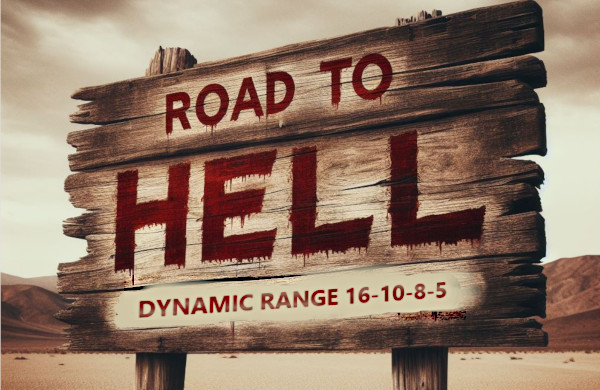
In the late 90's something went terribly wrong
As long ago as in 1982 red book CDs were released to the public. In the beginning it was a niche market, therefore recording companies put a very little effort in the mastering process and program material mostly remained untouched when being transferred onto a silver disc - such CD’s were often tracked at very soft levels due to engineers cutting straight from original analog mixes.
Only in the late 80’s, with commercial CD players exploding onto the market, a mastering became a legitimate profession. With more advanced digital equipment available in early 90’s mastering engineers could take a full advantage of CDs’ dynamic range without a need to compress or clip. This was a golden age for CD recordings.
THERE IS A THIN LINE BETWEEN LOVE AND HATE
How is it possible that you cannot enjoy your favorite music anymore? It is not your fault - it is the music with no or very limited dynamic range that is physically difficult to listen to for any length of time and urges you to skip the tracks. Quiet sounds and loud sounds are squashed together, there is no contrast anymore. It is not natural when four singers screaming their lungs out in a chorus are as loud as whisperred verses of a song, when an unplugged guitar beats a kick drum in its loudness. It’s also the reason why some people are still fanatical about vinyl recordings of the good old days. It’s not necessarily that the vinyl sounds better - it does not. It’s that it is impossible for a vinyl record to be fatiguing.
David Bendeth, producer
“Over the past decade and a half, a revolution in recording technology has changed the way albums are produced, mixed and mastered - almost always for the worse”
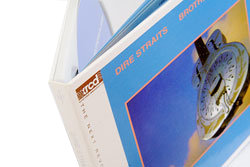 THE RISE AND FALL OF DIGITAL
THE RISE AND FALL OF DIGITAL
The major shortcoming of analog recording systems was always the noise floor of the medium, such as tape hiss or surface noise (crackles and pops) on vinyl records. ALL analog recording and playback media have some sort of inherent noise. To get as far away as possible from this noise floor the loudness of the track was increased. Thus program material was more clearly audible and farther above the noise and the dynamic range of a recording increased.
But all analog media also have their, technically speaking, ´saturation´ point: a limit over which the sound would become distorted. This type of distortion gives a hot, fuzzy, warmish sound. Can you remember how we were making tape recordings intentionally hotter by overmodulation to get a better signal to noise ratio? Sometimes it was used with care even by professionals to enhance immediacy of the material - e.g. Rolling Stones were famous for this and nobody have ever objected.
Binary digits have no inherited hiss or crackle (in fact, the CD playback requires the introduction of a small amount of randomized noise - dither). Zero in dBFS (full scale) is the the absolute highest level allowed for no clipping and distortion, unlike analog VU scale, where zero is the average level and sound swings above and below. The dBFS scale uses negative numbers to represent audio program level below the maximum zero. Typically, -20dbFS = 0dB on VU (i.e. 0dB on VU leaves approximately 20dB reserve for signal peaks on the dBFS scale).
There are different ways of dB level referencing. To illustrate one of the approaches, look at the following waveform - it is Dire Strait’s So Far Away from their legendary Brothers in Arms (1985, Vertigo, 824499-2). The album was mastered by Bob Ludwig and contributed tremendously, especially through its convincing sonic qualities, to the rise of CD format when it was still young. The paler waveform confined inside the spikes and peaks represents average volume levels of the track and jagged peaks that move up and down on the scale outline macrodynamics of the track. The bigger the distance between the peak level and the average level, the more competent is a track (micro)dynamics-wise.

From today’s point of view, the hereabove Dire Straits material was recorded in 1985 very quiet - there is a lot of headroom (i.e. it could have been louder). There is an occassional transient that comes closer to 0dBFS, but overall the peaks are hitting -5 to -8dBFS or even lower, and there is a sufficient reserve for the dynamic range. The original pressing of this CD features one of the biggest dynamic sweeps ever seen in rock music: Brothers in Arms measure as much as -18dB in microdynamics (the CD layer of the recent SACD remaster is, contrary to a popular misconception, not that courageous as it stops around -8dB). The level of -0.3dBFS formerly was considered as the loudest signal that was safe to put on a CD, since some early CD processors would treat a 0dBFS sample as an error. Thus the average level of audio is pretty low, but if you turn it up, these CDs may sound excellent.
The trick is that listeners judge how loud a sound is based on its average loudness, not its peak loudness. So even though there might be two tracks whose loudest parts (peaks) reach the same loudness level in dBFS, the one with a higher average level will be subjectivelly perceived as louder.
Dynamics is one of key elements in any music, perhaps the most important - it is virtually light and shade of the music. It creates a sense of spaciousness and makes it easier to pick out individual sonic elements - room reverberation, resonance of the wooden body of a guitar, the sound of strings being plucked, vocalist raising or lowering her/his voice, a sudden rush of drums, a quiet section bursting into a fortissimo passage - these elements bring an excitement to a music and when those things are neutered, the excitement is lost.
Jerry Tub, Terra Nova Mastering
“Listening to something that’s mastered too hot is like sitting in the front row at the movies - all the images are in your face.”
Transients, the peaks and valleys of a waveform, are necessary for the music to have a room to breathe. When compressors are cranked to excessive levels these transients are turned from sharp attacks to dull nubs and much of the detail is lost. The result is the sound that is unnatural, distorted and painful to listen to. Even if you like that type of sound initially you will not be able to enjoy it for more than couple of minutes without feeling significant discomfort.
Following two pictures show the same track: Garbage’s famous Milk. The first outtake is from the original CD (1995), the second sample comes from Absolute Garbage compilation released in 2007. Mastered by Emily Lazar and Sarah Register at The Lodge the latter version, though not clipped, is compressed and not nice to human ears at all.


Geoff Emerick, engineer on the Beatles’ Sgt. Pepper album
“A lot of what is released today is basically a scrunched-up mess. Whole layers of sound are missing. It is because record companies do not trust listener to decide themselves if they want to turn up the volume.”
THE DISTORTIONS WE LISTEN TO
There are number of ways to reduce the difference between the loudest and quietest parts of a musical track to either bring some instruments forward in a mix or make the track louder. Most of the methods, if applied insensitively, often result into reducing the original dynamic range of a recording.
One of the safest types is the normalization of a recording: the normalization process searches for a peak which is then turned up to 0dbFS together with the rest of the recording. The process does not change the ratios between peaks and the average loudness of the track. Thus you would get the hottest possible CD output without a distortion or change in dynamics.
 Sometimes just one transient (or a limited number of them) peaks over a signal’s average levels and therefore you won’t be able to squeeze much extra volume out of the signal. Here’s where a limiting comes into a play: if we just tame a small number (i.e. occassional) peaks, than we can get the entire signal hotter. Used properly this approach results in an imperceptible change to a small number of peaks and the whole signal can be made louder, sometimes considerably so. This approach also achieves maximum volume while still preserving 99% of the original material. The limiting is applied throughout e.g. Paul Simon’s Surprise album (1996, Warner). Mari Boine’ s Katrin Who Smiles (Goaskinviellja, 521 388-2 Verve, 1993) is another example: the picture shows the enormous dynamic range of the track which easily exceeds 15dBFS, however, if you look at the peak at around 4’48 minute mark, you will see that its waveform is clipped (´flat topped´).
Sometimes just one transient (or a limited number of them) peaks over a signal’s average levels and therefore you won’t be able to squeeze much extra volume out of the signal. Here’s where a limiting comes into a play: if we just tame a small number (i.e. occassional) peaks, than we can get the entire signal hotter. Used properly this approach results in an imperceptible change to a small number of peaks and the whole signal can be made louder, sometimes considerably so. This approach also achieves maximum volume while still preserving 99% of the original material. The limiting is applied throughout e.g. Paul Simon’s Surprise album (1996, Warner). Mari Boine’ s Katrin Who Smiles (Goaskinviellja, 521 388-2 Verve, 1993) is another example: the picture shows the enormous dynamic range of the track which easily exceeds 15dBFS, however, if you look at the peak at around 4’48 minute mark, you will see that its waveform is clipped (´flat topped´).

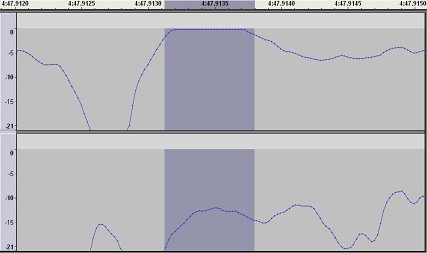
The isolated clipping is a very rare phenomenon throughout the album enabling music to sound louder by 3dB or more by sacrificing only a few isolated peaks - I would say it is perfectly okay. Similar approach was applied when John Atkinson mastered Attention Screen’s Live At Merkin Hall (STPH018-2) album for Stereophile label: it was possible to keep all samples unclipped but it was not necessary. Still, the dynamics of the album range between 10 to 15dBFS which is fine for a jazz recording.
Peter Mew, engineer on David Bowie’s classic albums
“The quieter parts are becoming louder and the loudest parts are just becoming a buzz. The brain is not geared to accept buzzing. The Cd’s become psychollogically tiring and almost impossible to listen to.”
One of the most misused methods to make the music more ear-grabbing is a compression - the loudest parts are made quieter (that is compressed through a compressor) and this allows turn the whole thing up. It does not distort music and does not clip but it will affect dynamic ratios of a music track. A more extreme kind of the compression is a compression at a very high ratio. Sonically it brings some (or all) instruments more forward in a mix and as a result it affects soundstaging. It is normally used by radios to make the output loudness level uniform. Every commercial radio uses some kind of audio processing in order to deliver a consistent volume level. If they do not do that we would have to adjust volume for each song - so the goal here is to make every song at a fairly equal volume. This is done by compressing, limiting and sometimes clipping the audio material, often together with some additional equalization. That’s also why a track on a radio would be mistakenly considered to be of ‘a higher quality’ than the same track played back through your consumer-grade home audio kit.
To visualize the difference between the beauty of being natural and the fuziness of a distorted reality please inspect the following images:
The first one is Leonardo da Vinci's reprint of famous Mona Lisa. The second picture is a compressed (low resolution) version of the same and finally, the third picture is ´clipped´, i.e. distorted a bit. No need to explain more. Now, you have an idea what a crap do we listen to?



Digital brickwall limiting is a more recent computer aided limiting in a digital domain by software plug-ins. If used sensitively it is very powerful as one can review his or her work before it is “published” - it does not necessarily cause flat-topping, but still removes the transient punch and impact from the sound.
Bob Dylan, musician in interview for Rolling Stone magazine
“You listen to these modern records, they are atrocious, they have sound all over them. There’s no definition of nothing, no vocal, no nothing, just like - static”
When you cannot compress or limit more, the only way to make your music even hotter is to simply chop off the peaks. Such a clipping results in perfectly flat lines of different lengths (which never occur in any naturally recorded music) and is the most ear fatigue inducing method to get the things loud.
CD digital audio runs at 44,1kHz (that is 44,100 samples per second). If, let’s say in a song, 10 samples are over the top, it’s 10/44100th of a second - far too quick to be heard. It means that not all clippings (the peaks that are over 0dBFS) are audible - the human hearing is very tolerant and forgiving. For example, Sony have introduced a three sample standard for measuring the level of distortion (i.e. 3 subsequent samples are over the limit) for the recording industry.
As a cheat sometimes a soft clipping method is used - the peaks over 0dBFS are lopped off but not flattened - instead the flat top is recreated again in a faked simulation of a rounded curve that looks like a natural part of the waveform). The soft clipping cannot be revealed by an inspection but if it is overdone it results in the same type of distortion as the standard clipping.
Roger Nichols, Grammy winning engineer for Steely Dan, Beach Boys and more (courtesy of Eq magazine, January 2002)
“I listened to all the CDs submitted to NARAS for cosnideration in the “Best Engineered Non-Classical” Grammy category. Every single CD was squashed to death with no dynamic range…the finalizers and plug-ins were cranked to eleven so that their CD would be the loudest. Not one attempted to take advantage of the dynamic range or cleanliness of digital recording.”
As an example let’s take my favorite German experimental thrashers from 80´s, Mekong Delta. The Transgressor track from their best to date Dances of Death album (1990, Aaarrg ARG23/034-2, mastered by Ralph Hubert) reads very low average loudness and its dynamic range peaks have an ample headroom of 14dB (!) - the CD is really very quiet and a volume control has to be turned up significantly to make it rock. However, it boasts one of the finest available dynamic ranges (16dB) and dynamic-wise it beats easily releases like The Dark Side of The Moon of Pink Floyd.
Unfortunately, this unique achievement was readily ‘fixed’ with the same track that appeared on the superb (viewed from the point of its track list) Mekong Delta’s compilation album in 2005 (Membran 223132-311). Can you spot the difference on the second picture? Despite the mutilation that was performed to the track it is not clipped at least, better say it is only soft clipped. You see that the dynamics of the track hardly exceed 5-6dBFS and there are no quiter moments - the track peaks all the way long. No need to say that sonically the difference between both CDs is a heaven and hell (the hell stands for the more recent version). Ironically enough, the booklet of this CD boasts with the sentence: 24bit/96kHz High-End Mastering! Even if I do not consider all those editing clicks (loud popping sounds) that are audible throughout the album I have to ask: With all my admiration towards your music, are you sane, Mr. Hubert?


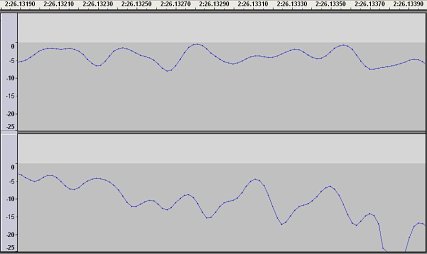
Probably not - let’s have a look at the very latest output of the band: Moderato has been taken out from Lurking Fear (2007, AFM Records, mastered by Ralph Hubert again). Such a CD could be listened to only in car and even there it sounds awfully.

In case of a digital recording, when peaks are clipped, they are lost forever. There is no way how to restore the information back - it means that the music is destroyed forever. A powerful blast of a kick drum should be quite loud and should have a sharp transient on the front of its waveform. In case of severe clipping, the wave produces just a quick blast of distortion and a dull thudding sensation (though it may be appealing to some non-audiophiles).
If you listen to an 80’s rock CD at a moderate volume, the drums are usually on the same level or a bit louder than vocals. But in today’s recordings it is all about SHOUTING - no drums, no beat or rhythm; during chorus, when a drum kit should be the loudest, it may be barely audible in a wall of sound, being turned into a clicking sound in a background noise!
Famous Californication of Red Hot Chilli Peppers and Elect The Dead of Serj Tankian (solo effort of the frontman of System of A Down) are both prime examples of the brutally distorted and squashed-to-death music.

 With Right On Time (RHCP, Californication, Warner 9362473862), produced by Rick Rubin, you can easily see the example (above) of such a wall of sound with practically no room for dynamics left. It is even impossible to speak about flattened peaks - there are simply no peaks anymore; almost everything is flattened at the maximum 0dBFS level. If you added up the number of missing digital data samples, you would find out that in certain moments over 55% of the song’s sonic information is missing!
With Right On Time (RHCP, Californication, Warner 9362473862), produced by Rick Rubin, you can easily see the example (above) of such a wall of sound with practically no room for dynamics left. It is even impossible to speak about flattened peaks - there are simply no peaks anymore; almost everything is flattened at the maximum 0dBFS level. If you added up the number of missing digital data samples, you would find out that in certain moments over 55% of the song’s sonic information is missing!
 Now, look at Tankian’s Empty Walls which is a favorite cut for many rock radios. Not only is it treated as badly as Californication but on top of that, the overall CD level is brought by 5dBFS down, preserving all the nasties at the lower volume. Was it a purpose or an accident? Does not really matter as the music strongly resembles the sound of your mobile phone no matter how good is your hi-fi gear.
Now, look at Tankian’s Empty Walls which is a favorite cut for many rock radios. Not only is it treated as badly as Californication but on top of that, the overall CD level is brought by 5dBFS down, preserving all the nasties at the lower volume. Was it a purpose or an accident? Does not really matter as the music strongly resembles the sound of your mobile phone no matter how good is your hi-fi gear.

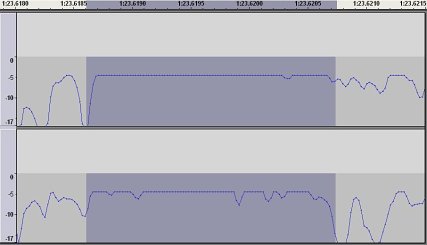
IS IT THAT BAD?
Good mastering is always a compromise. By equalization individual proportions of music could be changed, yet by an insensitive compression the whole original music idea could be destroyed. Ideally, mastering engineers should just transfer a tape onto a digital medium without leaving any imprint on its original sound. I still prefer some tape hiss to the hiss removed together with some music. So why there is a pressure on mastering studios to manipulate originals to the extent they are becoming harmful to our hearing?
Today, we listen to music in much noisier environments and use it rather as background. It is virtually everywhere - at work, in pubs, in cars, in shops, at airports. Moreover we want to listen to the music we love via iPods with headphones even in the noisiest of environments, in a constant hum from traffic in streets for instance. Have you ever tried to listen to a well recorded classical music piece in your car? You will probably find yourself to turn the volume of your car audio up and up in order to hear quiet parts and finally you will have to give up as you’ll be not able to hear a damn thing.
If an audio dealer wants to grab your attention and to highlight a certain component it is sufficient when he cranks up the volume a bit. The same technique is deployed by TV stations to grab your attention by commercials - have you ever noticed they are louder than the rest of a programme? The same effect used to be utilized already in the vinyl era with 45 singles - Motown label was notorious for cutting some of the hottest singles in industry, for example. They just made you dance. However, if you make music louder by +2 or +3 dB the next year you will have to add another 2dB to sound competitive. What was considered over the top one year, became standard the next. In the early to late 80’s, most pop records averaged around -15dBFS. Yet five years ago, CDs averaged at around -10 to -8 dBFS. Nowadays, modern recordings with a -2dB of dynamic range and no headroom are not an exception. In fact, this has become a rule!
When the red-book CD format was introduced, one of its promises was its potential for 96dB of a dynamic range. Higher resolution formats enhanced this potential to 144dB (DVD-A) or 120dB (SACD). From the softest sound up to a threshold of pain, human hearing can encompass a theoretical range of about 130dB. This is far above what we can use for our musical enjoyment at homes - despite the progress the new recording and playback technologies have made we are forced to buy and listen to recordings with their dynamic range not exceeding 2 to 5dB. Yes, it is that bad.
Bob Katz, recognized producer and sound engineer that is signed below more than 150 albums for the audiophile Chesky Records label and runs Digital Domain mastering studios, says: “Recently I have been addressed by a well known jazz pianist, with a trio of some of the finest jazz musicians on the planet, saying that he loved his master, but he’s willing to sacrifice its sound to make it a little more competitive loudness-wise. Why would he have to be the least bit concerned about a jazz recording being “competitively loud?” Today, with ongoing commercialization of jazz and classical music (with the help of movies and their scores) there are signs that the loudness war extends also to these territories, especially with the most popular releases. Fortunately, the classic labels are a bit more careful (or hesitant) as an insensitive and excessive digital treatment may easily ruin their reputation. When we move to rock and pop music we find ourselves amidst of a devastated battlefield.
Bob Katz, Digital Domain (sound engineer and ex-technical director of Chesky)
"There’s a 12-14dB apparent loudness difference between Black Sabbath produced in 1977 and transferred to compact disc in the early 80’s, and the Black Eyed Peas‘ Let’s Get It Started"
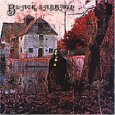 With rock legends it is quite risky for an engineer to make a messy mastering job. Here mastering engineers are much more careful and clipping occurs rarely though equalization and compression to a certain extent is widely applied to make the recorded material louder, as seen on one of the re-issues of Black Sabbath’s backcatalogue:
With rock legends it is quite risky for an engineer to make a messy mastering job. Here mastering engineers are much more careful and clipping occurs rarely though equalization and compression to a certain extent is widely applied to make the recorded material louder, as seen on one of the re-issues of Black Sabbath’s backcatalogue:

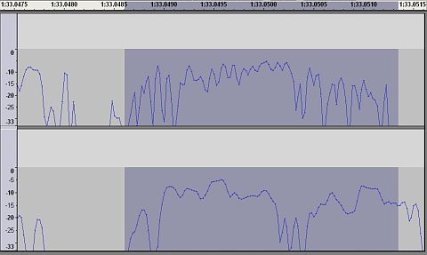
The above wave is out of The Wizard from their self-titled debut as it appeared on the Castle (RAWDD145) compilation album in 2000. You see that the crest wave still has enough headroom with its ca -5dBFS peaks. The average loudness of the re-release from 2004 (Sanctuary SMRCD031, remastered by Ray Staff of Whitfield Street Studios from original tapes) was increased by some +3dB which is still pretty safe for the peaks (below).

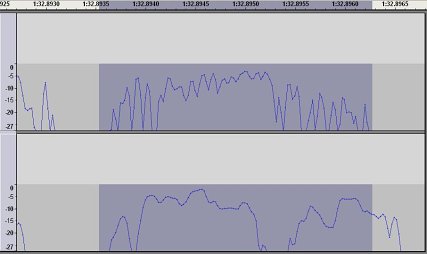
At the same time, a kind of noise reduction may have been applied which resulted in a slight alteration of transients (that are now visibly sharper) and it also facilitated clearer, less organic and more punchy sound (e.g.cymbals are perhaps too ‘metallic’) and audible changes in a soundstage focus, yet preserving most of its original dynamic scale.
Thus, the remastering job conducted on Black Sabbath’s debut as well as on the subsequent Paranoid album (Sanctuary SMRCD032, the same remastering credits and nice microdynamics of 11dB) is quite well done and with some minor criticism fully acceptable even in ´audiophile´terms.
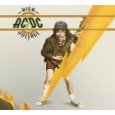 Also remasters of AC/DC’s High Voltage (7567-92413-2, Atlantic, remastered by Ted Jensen of Sterling Sound from original tapes, 1994) and Rainbow’s Rising (823 655-2, Polygram, remastered by Dennis M. Drake) could have been good achievements if the more drastic methods had not been applied. On She’s Got Balls from AC/DC’s debut not only you can see Mr. Jensen tried to maximize the overall loudness, but he also sacrificed a good deal of transients in favor of clipping - on the picture below the flattened wave parts containing as much as 7 samples in line are recognizable:
Also remasters of AC/DC’s High Voltage (7567-92413-2, Atlantic, remastered by Ted Jensen of Sterling Sound from original tapes, 1994) and Rainbow’s Rising (823 655-2, Polygram, remastered by Dennis M. Drake) could have been good achievements if the more drastic methods had not been applied. On She’s Got Balls from AC/DC’s debut not only you can see Mr. Jensen tried to maximize the overall loudness, but he also sacrificed a good deal of transients in favor of clipping - on the picture below the flattened wave parts containing as much as 7 samples in line are recognizable:

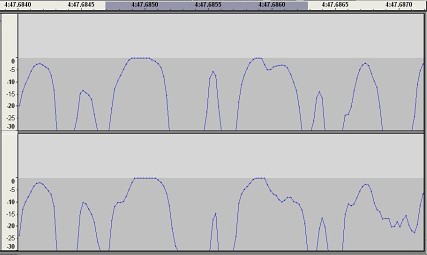
Fuelling further distortion into already ‘distorted’ guitar rock riffing is not a disaster and it is forgivable - the music is more crispy, punchy and really rocks; anyway, when you compare it to an original vinyl pressing you would hear that the remastered version is a bit over the top.
Here and there you can hear voices calling for a jihad against some mastering engineers for their inconsistent work but in my opinion it oversimplifies the problem. For sure, the mastering engineers should not be the ones to promote aforementioned sound mutilations - this should be considered a professional suicide. However, there is an existing pressure from their customer, that is a label or often from even an artist, that forces them go over the top.
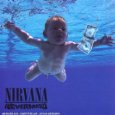 Let’s take, for instance, famous Masterdisk studios and Howie Weinberg - this guy is behind some legendary releases like Nirvana’s Nevermind (1991, Geffen 424425-2). Despite Nevermind is not considered to be a real audiophile treat, it was pretty innovative and you cannot deny it set new standards for loudness levels and new ways of mastering. By the way, despite occassional and forgivable clipping Smells Like A Teen Spirit enjoys remarkable 12dB of its dynamic range which is a top notch achievement for an indie record (below).
Let’s take, for instance, famous Masterdisk studios and Howie Weinberg - this guy is behind some legendary releases like Nirvana’s Nevermind (1991, Geffen 424425-2). Despite Nevermind is not considered to be a real audiophile treat, it was pretty innovative and you cannot deny it set new standards for loudness levels and new ways of mastering. By the way, despite occassional and forgivable clipping Smells Like A Teen Spirit enjoys remarkable 12dB of its dynamic range which is a top notch achievement for an indie record (below).

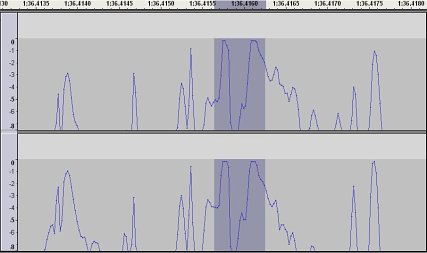
Unfortunately, Howie Weinberg’s more recent mastering projects are far from being acceptable - the list of popular artists whose recordings have been squashed beyond recognition is long, with prime example of frequently discussed and totally unlistenable Rush’s Vapor Trails that should be nominated as one of the worst achievements of mastering to date. There are petitions on the internet calling for Vapor Trails to be properly re-mastered and even more voices are calling for a re-issue of Metallica’s recent Death Magnetic CD (mastered by Ted Jensen) which shows signs of terrible compression in comparison with its PlayStation (!) version. It is a miracle (or rather a pitiful fact) that such a release was awarded by Grammy for its sound quality.
DOES MODERN REMASTERING ALWAYS MEAN A CONSPIRACY?
Not necessarily. However, it is more and more difficult to find a music material which has benefited from its enhanced quality due to a proper remastering process. One of the examples could be the new Dead Can Dance set that is available in a hybrid SACD/CD format.
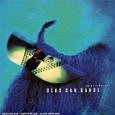 Some of the original material, released on CDs in 90’s, was already of a pretty nice sound quality and the high-resolution of the SACD justified perfectly the re-release. Fortunately, as albums come as hybrid discs, we can also enjoy the enhancement in the standard of 16bit/44.1kHz. Let’s take a look at the samples picked out from great Spirit Chaser CD (4AD, CAD 6008, 1997, no mastering credits) - the track number 4, The Song of Dispossessed. Peaks go up to 0dbFS level but because the track’s average loudness is pretty low, the peaks generate a remarkable dynamic range. I do not know if the CD was either normalized or carefully mastered but you can hardly reveal signs of any insensitive compression - if one really tries hard than there is a peak or two that had been cut off (see the picture below), however, the effect of this is inaudible as it goes beyond the human hearing sensitivity.
Some of the original material, released on CDs in 90’s, was already of a pretty nice sound quality and the high-resolution of the SACD justified perfectly the re-release. Fortunately, as albums come as hybrid discs, we can also enjoy the enhancement in the standard of 16bit/44.1kHz. Let’s take a look at the samples picked out from great Spirit Chaser CD (4AD, CAD 6008, 1997, no mastering credits) - the track number 4, The Song of Dispossessed. Peaks go up to 0dbFS level but because the track’s average loudness is pretty low, the peaks generate a remarkable dynamic range. I do not know if the CD was either normalized or carefully mastered but you can hardly reveal signs of any insensitive compression - if one really tries hard than there is a peak or two that had been cut off (see the picture below), however, the effect of this is inaudible as it goes beyond the human hearing sensitivity.
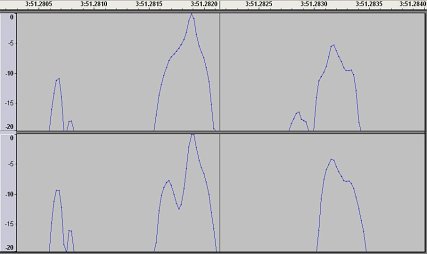
 During the remastering process (Dead Can Dance, Spirit Chaser, MFSL remastered Hybrid SACD/CD SAD2713, 2008), Neal Harris of Mobile Fidelity Sound Lab treated those small imperfections (on the picture you can see that the lopped-off peaks are back) to enhance the sound quality the MFSL way:
During the remastering process (Dead Can Dance, Spirit Chaser, MFSL remastered Hybrid SACD/CD SAD2713, 2008), Neal Harris of Mobile Fidelity Sound Lab treated those small imperfections (on the picture you can see that the lopped-off peaks are back) to enhance the sound quality the MFSL way:
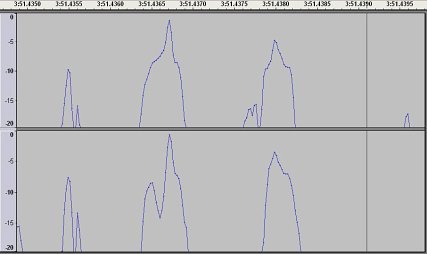
Though these ‘improvements’ are not significant on their own (the difference between the original flattened peak and the new reconstructed peak is below 0.4dBFS), their cumulative effect has an impact on the sound. The MFSL version is compressed to a very little extent, so its overall RMS (average loudness) is a bit higher, but this was necessary to get all the details and transients right. The resulting sound acquired a higher level of clarity and brilliance, indeed.
Another example of a success story of modern remastering is Mike Oldfield’s Tubular Bells (25th Anniversary Edition, Virgin CDVX2001, remastered by Simon Heyworth) or famous Rolling Stones backcatalogue. The latter was transferred to SACD/CD hybrids for ABKCO label by joint efforts of Teri Landi, Steve Rosenthal, Jon Astley and Bob Ludwig.
In an interview for Pro Audio Review magazine Bob Ludwig described how painstaking the whole process had been:
“I would put up a song and EQ it the way I thought it should be. Then I checked it against original London and Decca pressings and also checked the singles if the original was mono. Next, the 1986 CDs would be checked as this was source for probably 90% of the people who know these songs.”

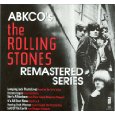 To get the most out of the medium, also Rolling Stones transfers have been compressed, using analog compressors (Manley, Millenia Media or NTP) to get the ‘correct’ sound. Ludwig Co. went step by step through all tracks to erase or minimize all nasties inherited from the master tapes: “When there were spots that required the use of noise reduction I would do it, if it was possible in the analog world. If not, we went to the high-resolution PCM format. If neither sounded that great, we just let the noise be.” Though the issue was targeted to an SACD audience, its CD layer benefits significantly from the Sony’s Super Bit Map Direct SACD to PCM downsampling and the final remaster has become one of the milestones in the industry.
To get the most out of the medium, also Rolling Stones transfers have been compressed, using analog compressors (Manley, Millenia Media or NTP) to get the ‘correct’ sound. Ludwig Co. went step by step through all tracks to erase or minimize all nasties inherited from the master tapes: “When there were spots that required the use of noise reduction I would do it, if it was possible in the analog world. If not, we went to the high-resolution PCM format. If neither sounded that great, we just let the noise be.” Though the issue was targeted to an SACD audience, its CD layer benefits significantly from the Sony’s Super Bit Map Direct SACD to PCM downsampling and the final remaster has become one of the milestones in the industry.
WHAT WILL HAPPEN NEXT?
It’s clear that the as-loud-as-possible epidemics will not stop in near future. There are no signs of recovery: the latest Rammstein’s opus Liebe ist fur Alle Da (2009, Universal 2721359, mastered by Erik Broheden and Henrik Jonsson at Masters of Audio, Stockholm) is, due to a rough digital processing, sonically not far from the sound of your Nokia cell phone. A prime example of how a piece of music can be killed by an incompetent treatment.


Before this article was published I had come across another 'sonic gem' - the latest output of Combichrist (What's The F***k is Wrong with You CD). The title of the CD is an excellent choice; if you look at the waveform (below) you really have to ask the very same question...
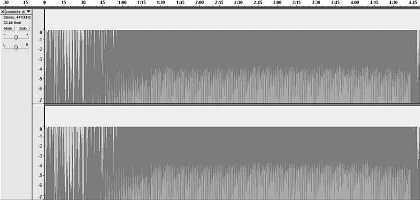
Not to be confined only to a rock territory, Michael Jackson’s post-mortem This is It (Sony/Epic 88697606742) is another example of such an incompetence: where original releases showed nice dynamics of up to 13dBFS, there left hardly half of it on This is It.
By now, any audio enthusiast should have already realized that excellent dynamic capabilities of a recording do not mean that its sonics are excellent too. There are many examples of recordings that, despite their decent dynamic range, failed at some other stage in their mix and left a demanding listener dissapointed with the lack of an ultimate resolution, soundstaging precision or perhaps just an emotional communication. On the other hand, even if the aforementioned audiophile requirements are met, without appropriate dynamics the music turns out to be a crap.
An audio forum member:
“When CDs came about I got rid of all my cassettes and vinyl records and replaced them with the CD versions. When MP3 came around I downloaded my face off. Now I feel like an idot.”
During the preparation of this article throughout 2009 I analyzed more than 300 rock and pop albums for their dynamic range and the level of their compression. I would like to bring better news but I am very sorry: the more recent a title is the more it is affected. Unless we talk about carefully supervised anniversary editions you can hardly expect a well executed mastering job today. On the contrary - when you spot a ´remastered´label on the jewel box of a CD you have to become very suspicious about its quality. The green line on the picture below shows average dynamics of CDs fifteen years ago, the red line shows the situation of today. The CDs that used to have 14dB dynamics in the late 80´s hardly hit at least 5dB level when remastered. Today, the ´REMASTERED´label can be easily replaced by a ´STAY AWAY!´label in 90% of the cases.
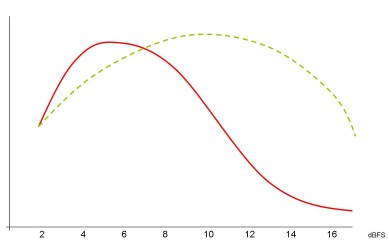

We may only hope that the plague will not spread furthermore. There is a significant advantage - a cheap and quick remedy is available. Since 2008, Audiodrom has been therefore a proud member of TurnMeUp! initiative (http://www.turnmeup.org/) which has already grown up to quite a strong movement that is gaining its momentum.
Started by the sound engineer Charles Dye, supported by such authorities like Bob Katz or Bob Ludwig and many more, TurnMeUp! leads the campaign to restore to artists the choice to release more dynamic-sounding records. The Turn Me Up! website (www.turnmeup.org) includes a great tutorial video on the loudness issue, as well as a growing list of links to articles on the subject.

We are also keen supporters of another initiative The Pleasurize Music Foundation (http://www.pleasurizemusic.com/) which began operations in January 2009 and is a nonprofit organization based in California, USA. This organization has quite an ambitious goal to convince record companies to release albums with the minimum dynamic range of 14dB or, alternatively, to give less dynamic albums appropriate headroom and label them with a logo showing their actual dynamic range. We encourage you to learn more on their web where you can also find a software tool for the dynamic range measurement.
By widespreading the message (Stereophile magazine is one of those relentlessly rebelling) and developing enough pressure on artists themselves (remember the latest outputs of Depeche Mode or Metallica that dissapointed many) there surely will be a day again, when we would be buying music without the fear that it will damage our souls and ears.
As Graham Sutton, musician and sound engineer says:
“The brick wall has been reached. I wonder how long it will be before the record companies re-re-release their back catalogue, re-re-remastered for additional dynamic range.”
Related article: Echoes of Sonisphere - The Magical Fours
© Audiodrom, 2010 MJ



